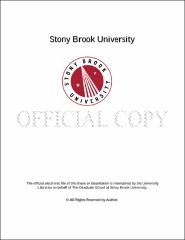| dc.identifier.uri | http://hdl.handle.net/11401/77100 | |
| dc.description.sponsorship | This work is sponsored by the Stony Brook University Graduate School in compliance with the requirements for completion of degree. | en_US |
| dc.format | Monograph | |
| dc.format.medium | Electronic Resource | en_US |
| dc.language.iso | en_US | |
| dc.publisher | The Graduate School, Stony Brook University: Stony Brook, NY. | |
| dc.type | Thesis | |
| dcterms.abstract | Matrix Metalloproteinases (MMPs) are a family of more than 25 structurally-related enzymes that can degrade a variety of substances including collagen. Basal levels of these enzymes play an important role in tissue turnover under normal physiological conditions, while excessive levels of these enzymes may cause or exacerbate many diseases related to tissue loss, including arthritis, cancer, cardiovascular disease, coma, periodontal disease, stroke etc. For decades, research teams from both industrial companies and academic institutions have been trying to develop an effective matrix metalloproteinase inhibitor as a drug to treat MMP-involved diseases. Our group have been working on MMP inhibitor development for several years and two families of compounds which possess 1,3-dicarbonyl functionality have been investigated. These two families are bis-aroyl methanes (BAMs) and chemically-modified curcumins (CMCs). Up to now, 23 CMCs have been synthesized and the results published, CMC 2.24 [1,7-bis-(4-hydroxyphenyl)-4-phenylaminocarbonyl-1E,6E-heptadien-3,5-dione] exhibits excellent inhibitory effect against a series of chosen MMPs. Further indications suggested that modification on the 4-substituent of CMC 2.24 could increase both the inhibitory effect and water-solubility. Having this in mind, a 4-hydroxy derivative of CMC 2.24 was synthesized in addition to the four other CMCs. BAMs are the bis-nonvinylene analogues of CMCs, and eight new BAM compounds were synthesized and seven of them were tested in vitro as inhibitors against MMP-9. The synthesis of these five CMCs and eight BAMs as well as the biological screening of seven BAMs will be discussed in this work. | |
| dcterms.available | 2017-09-20T16:51:57Z | |
| dcterms.contributor | Parker, Kathlyn | en_US |
| dcterms.contributor | Johnson, Francis | en_US |
| dcterms.contributor | Koch, Stephen. | en_US |
| dcterms.creator | Chen, Yijun | |
| dcterms.dateAccepted | 2017-09-20T16:51:57Z | |
| dcterms.dateSubmitted | 2017-09-20T16:51:57Z | |
| dcterms.description | Department of Chemistry. | en_US |
| dcterms.extent | 125 pg. | en_US |
| dcterms.format | Monograph | |
| dcterms.format | Application/PDF | en_US |
| dcterms.identifier | http://hdl.handle.net/11401/77100 | |
| dcterms.issued | 2013-12-01 | |
| dcterms.language | en_US | |
| dcterms.provenance | Made available in DSpace on 2017-09-20T16:51:57Z (GMT). No. of bitstreams: 1
Chen_grad.sunysb_0771M_11666.pdf: 3014425 bytes, checksum: fcf1e30cf16c3f20139d74526e54829b (MD5)
Previous issue date: 1 | en |
| dcterms.publisher | The Graduate School, Stony Brook University: Stony Brook, NY. | |
| dcterms.subject | Chemistry | |
| dcterms.subject | BAM, CMC, Inhibitor, MMP | |
| dcterms.title | Synthesis and Preliminary Biological Screening of Bis-aroyl Methanes and Chemically-modified Curcumins as Matrix Metalloproteinse Inhibitors | |
| dcterms.type | Thesis | |

